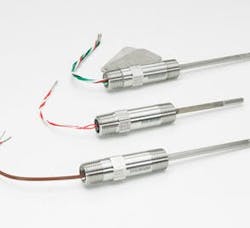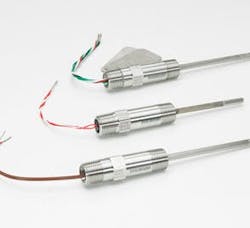Temperature plays a critical role in nearly every industrial operation throughout the process industries. In some highly sensitive processes, a change in temperature of as little as 1–2% can result not only in the loss of hundreds of thousands of dollars but also in the creation of a potentially dangerous situation. That’s why knowing which temperature measuring device to use for an application is so important.
Figure 1. Options include dual, 3-wire RTD (top); single, 4-wire RTD (center); and Type K thermocouple (bottom).
Resistance temperature detectors (RTDs) and thermocouples are the most commonly used sensor types in the process industry today. Each operates on different physical principles and offers distinct advantages and disadvantages when it comes to meeting requirements for accuracy, repeatability, stability and cost. Neither device is inherently superior to the other.
RTDs operate on the principle of thermal resistivity. As temperature rises, the electrical resistance of a metal increases and, because the exact degree of this increase is known, local temperature can be determined by simply monitoring the change in resistance of an RTD element.
The two most-common types of RTD sensors are wire wound and thin film. A wire-wound RTD is made either by winding the resistive wire around a ceramic mandrel or by winding it in a helical shape supported in a ceramic sheath. To manufacture a thin-film RTD sensor, a resistive coating is deposited on a flat — usually rectangular — ceramic substrate.
Thermocouples are closed-circuit devices that consist of two wires of dissimilar metals joined at both ends. These sensors take advantage of a phenomenon known as the Seebeck Effect, in which the temperature differential between two different metals produces a current that can be measured and correlated to a thermal reading.
Key Selection Criteria
Process engineers must regularly choose between using an RTD or a thermocouple. Because the right decision highly depends upon the specific application, it’s important to carefully consider factors such as temperature range, measurement accuracy, sensitivity, process vibration and cost.
Temperature range. Although the lower temperature limits of the two devices are relatively similar (~-250°C), thermocouples have a much higher upper limit. This is largely because thermocouples come in many configurations (Type B, E, J, K, R, S, T) that suit different ranges depending upon the material makeup and thickness of wires used.
Thermocouple sensors that feature base metals are generally used for processes with lower temperature ranges (-200°C to 1,200°C) while sensors featuring precious metals are installed for processes with higher ranges (1,000°C to 1,800°C). RTDs, on the other hand, typically have an upper limit of ~850°C and, as a result, they are more widely used in applications with low to moderate operating temperatures.
Accuracy, repeatability and stability. The resistivity of certain metals at different temperatures is well documented and highly predictable; because of this, RTDs can determine local temperature with a much higher degree of both precision and consistency than thermocouples.
Common RTD elements such as copper, nickel and platinum also exhibit large changes in resistance per degree of temperature change, which gives them excellent sensitivity over narrow spans. In addition, RTDs demonstrate better linearity than thermocouples. When provided with CVD (Callendar-Van Dusen) constants and coupled with high-quality transmitters, RTDs can attain measurement accuracy of up to 0.1°C.
Unlike long-term drift in thermocouples — which can be large and rather erratic in some applications — drift observed in RTDs is much smaller and more predictable. Hysteresis is negligible in RTDs as well.
Impurities in RTD elements and dimensional variations in wire can cause interchangeability error. Thus, the industry categorizes RTD sensors into two classes based on accuracy: Class A and Class B. Class B sensors suffice for most applications; however, where better accuracy and precision are critical to safe and effective operation, Class A may be more appropriate.
Process vibration and durability. Some thermocouples can withstand as much as 60 times the force of gravity (60 G). In contrast, a standard RTD typically is designed for only 2 to 3 Gs. In some circumstances, RTDs can be manufactured to withstand high vibration environments — however, this requires special treatment that may significantly boost the cost of the devices.
When it comes to protection against electromagnetic interference (EMI) and radio frequency interference (RFI), RTDs generally are a better option. The less-robust signals of thermocouples make them more susceptible to EMI and RFI issues. (Ungrounded thermocouples offer more protection against EMI than do grounded thermocouples but often exhibit slower response times. Isolation of thermocouple sensors can help improve reliability and reduce costly calibration and maintenance requirements as well.)
Using a transmitter with either an RTD or a thermocouple can minimize interference issues. The 4–20-mA HART signal of a transmitter is much more robust than the raw resistance or mV signal of an RTD or thermocouple, respectively.
Cost. Though the initial cost of a thermocouple typically is less than that of a platinum RTD, thermocouples often require frequent maintenance and calibration because of wire corrosion. Moreover, thanks to the more moderate environments in which they operate, RTDs generally have a longer useful life.
Thermocouples also need matching extension wires for each sensor configuration, which can drive up material costs, especially for long wire runs. RTDs, on the other hand, can be connected with standard copper wire. This, coupled with significantly reduced calibration requirements, makes them more attractive from a total-cost-of-ownership standpoint.
Making the Right Choice
RTDs and thermocouples each offer distinct advantages and disadvantages that must be considered in the context of the measurement requirements of an application. Reviewing process and instrumentation drawing, making site visits, and consulting with engineers and managers to better understand what those requirements are is a key step on the way to choosing the most-suitable temperature sensor and ensuring a safe, efficient and profitable operation.
OMAR GHAZI is a marketing engineer for Emerson Process Management, Shakopee, MN. E-mail him at [email protected].

